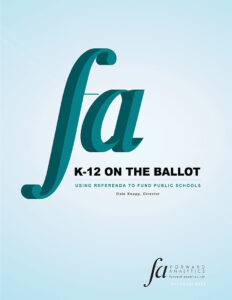K-12 On The Ballot: Using Referenda to Fund Public Schools

A new report from Forward Analytics, K-12 On The Ballot: Using Referenda to Fund Public Schools, shows Wisconsin’s K-12 schools increasingly rely on dollars approved at referenda to fund local education.
In 2022, these dollars funded more than 5% of statewide education spending, but reliance was much greater in many districts. In 100 districts, referenda-approved dollars funded more than 10% of district spending. These dollars paid for more than 25% of spending in 14 of those districts.
In 1993, Wisconsin adopted a school funding formula that imposed revenue limits on school districts – stating that a school district’s revenue limit is the maximum amount of revenue that may be raised from state aid and local property taxes.
Since 1993, when revenue limits were created, 356 of 434 school districts have put more than 1,500 operating referendum questions on the ballot, with 58% of them approved. In 2023, referendum-approved spending totaled $650 million, up from $180 million in 2010.
According to the report, districts with declining enrollment were more likely to go to referendum and have those referenda approved. Districts with a 10% decline in enrollment are 1.7 times more likely to go to referendum than districts with rising enrollments.
The state’s smallest districts, those with fewer than 500 students, were more likely to use referenda to fund operations. In 2022, 69% of such districts were using referenda-approved funding, with two-thirds of them using these dollars to pay for more than 10% of their education spending.
This report raises important questions about Wisconsin school funding, particularly the growing reliance on referenda to pay for education services.
“There are no easy answers,” said Forward Analytics Director Dale Knapp. “I don’t think the lawmakers who created this law envisioned referenda being relied on this much. Maybe the answer after 30 years of the limits is an in-depth review of the law to see how it can be improved to continue protecting taxpayers and ensure adequate funding of our schools.”
Find the entire report, K-12 On The Ballot: Using Referenda to Fund Public Schools, here.
Report Highlights
- During 1997- 2010, 44% of all operating referenda were approved. After 2010, the rate increased to 76%.
- The amount of referendum-approved dollars funding K-12 schools has grown rapidly. This funding increased from $32 million in 2000 to $180 million in 2010 and to $650 million in 2023.
- Of the 434 unique school districts during the revenue limit era, 356 (82%) have used the referendum option at least once. Most used the option three times or less: 65 have used it once, 67 twice, and 68 three times. By contrast, nearly 20% of districts used the referendum option six times or more, with 15 using it at least 10 times.
